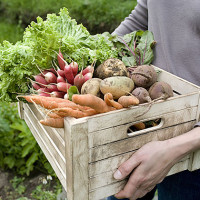Who knew that a simple lettuce leaf could elicit such joy when picked from one’s own garden? Before this summer, certainly not me. As I venture out my back door each day to check the progress of the vegetables I planted with my very own hands, I find myself giddy with surprise and delight at how they have not only survived, but are thriving and providing me with food that actually tastes good.
But you needn’t be a home gardener to get excited about summer vegetables. In fact, it would be hard not to get excited about vegetables this time of year since they are so abundant and diverse. Some of the most delicious summer vegetables include corn, zucchinis, cucumbers, eggplants, tomatoes and green beans. Given their current high tide, it seems an ideal time to share some quick tips and tricks for getting the most nutrition from your veggies.
The first thing to know about vegetables is that they provide the broadest range of nutrients of all the food classes, so maintaining as many of their vitamins and minerals as possible prior to eating is very important. There are several factors that affect the nutritional content of vegetables, such as when they were picked, how they have been stored (and for how long), if they are organic or not and how they were prepared.
As soon as a vegetable is picked and separated from its life-source, it begins to slowly deteriorate. The longer vegetables sit after being picked, the more nutritional value they lose. If you want to get the most nutrients and flavor for your money, seek out vegetables that are as fresh as possible. This is best achieved by picking from your own garden, or buying from farmers markets or local farm stands where the vegetables will have likely been picked within the last 24 hours.
A good rule of thumb is to buy vegetables fresh when they are in season, as they will most likely have been locally grown and recently harvested, thereby providing a great deal of nutrients. When certain vegetables are out of season, buying them frozen is a good alternative, as they are frozen at their peak of ripeness when they are most nutritious. Canned vegetables also maintain good nutritional value (depending on how they have been heated prior to canning), as they too are processed when ripe. Canned vegetables, however, are usually loaded with added salt. For this reason, thoroughly rinse them after opening.
Fresher vegetables will generally be aromatic and firm to the touch (not soft from sitting around too long). If you shop for vegetables at a grocery chain, be wary of sales as the store may be trying to unload things that are beginning to turn. Light, oxygen, temperature and humidity all affect the freshness of vegetables (dark and cool storage is best). In addition, grocery store vegetables are often picked before they have fully ripened so that they will not overly ripen during transit and storage; but unfortunately this inhibits the vitamins and minerals from completely developing in the first place.
When buying vegetables, consider buying organic since the body runs best on unadulterated, whole foods. Organic vegetables can cost a bit more, so if you’re on a budget and want to buy organic, visit www.foodnews.org for a ranking of 43 fruits and vegetables according to their toxic loads. This list will help you balance your organic vegetable choices (those containing little or no pesticides) with your conventionally grown vegetable choices (those with the highest pesticide loads) in a more informed manner.
In order to maintain as many intact nutrients during preparation, try eating a larger percentage of your vegetables raw. Cooking at high heat alters the nutritional composition of foods, decreasing the vitamins and minerals available to our body, and inactivates the food’s naturally occurring enzymes that aid digestion. A simple way to incorporate a good percentage of raw vegetables into your diet is to eat at least one hearty green salad a day.
When cooking vegetables, try steaming instead of boiling; more nutrients will be maintained within the vegetables this way. (Denser veggies, such as cauliflower, beets and potatoes also do well steamed.) If you are stir-frying vegetables, try using a small amount of water or vegetable broth instead of oil for a healthier option and one that won’t mask the natural flavors of the vegetables.
So, as the saying goes: Eat your veggies! Summer’s here, and fresh is best.
Cathy Fisher is a certified Nutrition Educator and resides in Glen Ellen. The Sun welcomes feedback from our readers. Please address comments and questions to feedback@sonomasun.com.




